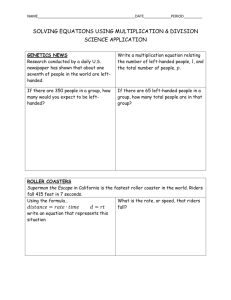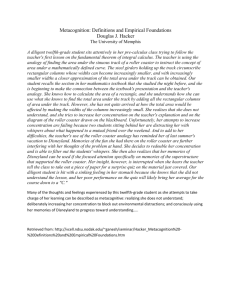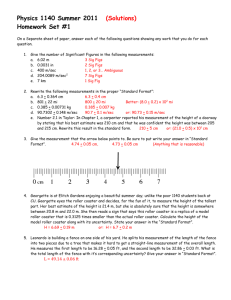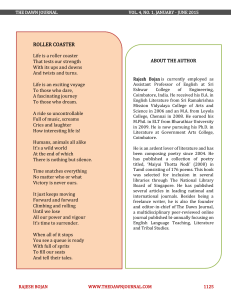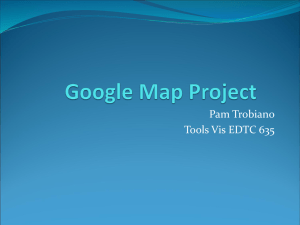Standards: Curriculum:
advertisement
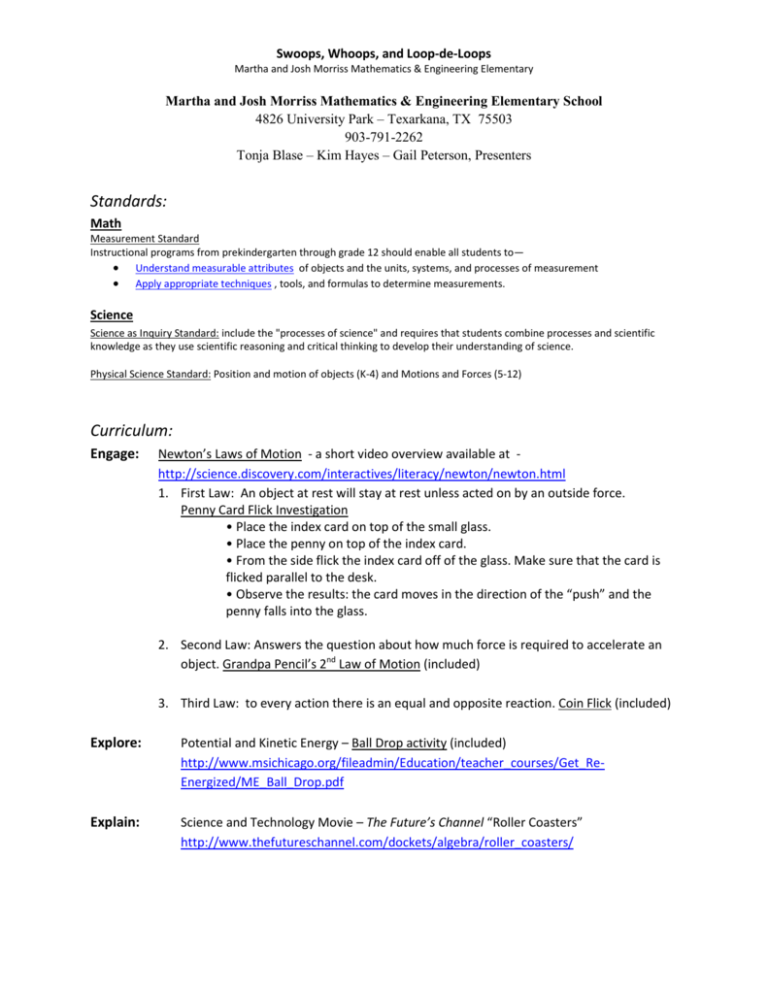
Swoops, Whoops, and Loop-de-Loops Martha and Josh Morriss Mathematics & Engineering Elementary Martha and Josh Morriss Mathematics & Engineering Elementary School 4826 University Park – Texarkana, TX 75503 903-791-2262 Tonja Blase – Kim Hayes – Gail Peterson, Presenters Standards: Math Measurement Standard Instructional programs from prekindergarten through grade 12 should enable all students to— Understand measurable attributes of objects and the units, systems, and processes of measurement Apply appropriate techniques , tools, and formulas to determine measurements. Science Science as Inquiry Standard: include the "processes of science" and requires that students combine processes and scientific knowledge as they use scientific reasoning and critical thinking to develop their understanding of science. Physical Science Standard: Position and motion of objects (K-4) and Motions and Forces (5-12) Curriculum: Engage: Newton’s Laws of Motion - a short video overview available at http://science.discovery.com/interactives/literacy/newton/newton.html 1. First Law: An object at rest will stay at rest unless acted on by an outside force. Penny Card Flick Investigation • Place the index card on top of the small glass. • Place the penny on top of the index card. • From the side flick the index card off of the glass. Make sure that the card is flicked parallel to the desk. • Observe the results: the card moves in the direction of the “push” and the penny falls into the glass. 2. Second Law: Answers the question about how much force is required to accelerate an object. Grandpa Pencil’s 2nd Law of Motion (included) 3. Third Law: to every action there is an equal and opposite reaction. Coin Flick (included) Explore: Potential and Kinetic Energy – Ball Drop activity (included) http://www.msichicago.org/fileadmin/Education/teacher_courses/Get_ReEnergized/ME_Ball_Drop.pdf Explain: Science and Technology Movie – The Future’s Channel “Roller Coasters” http://www.thefutureschannel.com/dockets/algebra/roller_coasters/ Swoops, Whoops, and Loop-de-Loops Martha and Josh Morriss Mathematics & Engineering Elementary Coaster Creator Lesson http://www.jason.org/digital_library/4851.aspx Design a virtual roller coaster : http://www.learner.org/interactives/parkphysics/coaster.html Elaborate: 1. Rube Goldberg machines –“a comically involved, complicated invention, laboriously contrived to perform a simple operation” www.rubegoldberg.com Watch Rube Goldberg Music video http://www.youtube.com/watch?v=qybUFnY7Y8w Set up challenge – see rubric for assessment 2. Tennis Ball Roller Coasters - http://www.discoveryeducation.com/teachers/freelesson-plans/the-ultimate-roller-coaster-contest.cfm Tell students they will be designing and constructing “tennis ball” roller coasters with three hills. The tennis ball in each design must start from the top of the first hill, roll up and down the other two hills, and exit the end of the track. Each roller coaster will be judged in a class competition. The track with the greatest total of vertical heights for all three hills – if the tennis ball completes the course – will be named the winning design. Have students consider the following when designing their roller coasters: Can all the hills be the same height? If not, why? Can they get bigger or must they get smaller? How will you determine how big or how small the hills can be and still win this contest? Does the steepness of the hill count? Is it better to make the hills steep or not so steep? Why? How curvy should the tops of the hills and the valleys be? Should you design sharp turns or smooth turns? Why? What provides resistance on the roller coaster causing the tennis ball to slow down? How can this resistance be reduced? Note: Leave students with enough time to make revisions to their original design—an important factor in the world of design and engineering. Divide students into small groups and give each group the materials listed earlier. The left and right roller coaster tracks will be made from the two pieces of corrugated cardboard that must be cut out as identical shapes. Each valley in the roller coaster must dip to a height of 20 centimeters from the bottom of the cardboard. Use heavy-duty scissors or a box knife to cut out both tracks (we use parent volunteers that day). They will probably have their own ideas on how the roller coaster should be shaped, but here is an idea on how to lay out the roller coaster on the cardboard. Swoops, Whoops, and Loop-de-Loops Martha and Josh Morriss Mathematics & Engineering Elementary From the excess cardboard, students should cut out twenty-five 4 cm x 12 cm rectangles. These rectangles will serve as spacers between the two cutout tracks. Put glue along both of the 12centimeter edges and fasten them to various places between the two tracks so that the tracks are rigid and separated by a distance of 4 centimeters. Here is an example of how the score for a roller coaster should be calculated for the contest. Measure the heights of each of the three required hills and add them up. The roller coaster with the greatest total height of the three hills, whose tennis ball successfully completed its journey, is the winner. 3. Card Stock Roller Coasters – http://pbskids.org/zoom/activities/sci/rollercoaster.html Build a roller coaster using a marble, oak tag, tape, books, and a cup. Cut the oak tag into strips that are 2 inches wide and 11 inches long. Tape these strips together to make your roller coaster track. The marble will be the cart that travels along the track. You can use books to build hills and ramps (or you can use a staircase). You get 3 points for each U-turn, 5 points for each loop, and 1 point each time you make the marble go up a hill. If you can get the marble to fly through the air and land in a cup, you earn an extra ten points. Evaluate: See Rubrics (included) Sources: Ball Drop. msichicago.org. Retrieved from http://www.msichicago.org/fileadmin/Education/teacher _courses/Get_Re-Energized/ME_Ball_Drop.pdf Measurement Standard. (2012). National Council of Teachers of Mathematics (NCTM). Retrieved from http://nctm.org/standards/content.aspx?id=316 National Science Education Standards. (2012). National Academy of Sciences (NSTA). Retrieved from: http://www.nsta.org/publications/nses.aspx Swoops, Whoops, and Loop-de-Loops Martha and Josh Morriss Mathematics & Engineering Elementary Paper Roller Coaster. Mr. Wayne’s Class.Com. Retrieved from http://www.mrwaynesclass.com/ProjectCoaster/Lab/index.html Roller Coaster. (2012). Amusement Park Physics. Retrieved from http://www.learner.org/interactives/parkphysics/coaster.html SCI-Discovery Communications. (2012). Newton’s Laws of Motion Interactive. Retrieved from http://science.discovery.com/interactives/literacy/newton/newton.html Rube Goldberg. (2012). Rube Goldberg, Inc. Retrieved from http://www.rubegoldberg.com/ Roller Coaster. (1998-2010). Zoom-Science Rocks! Retrieved from http://pbskids.org/zoom/activities/sci/rollercoaster.html

